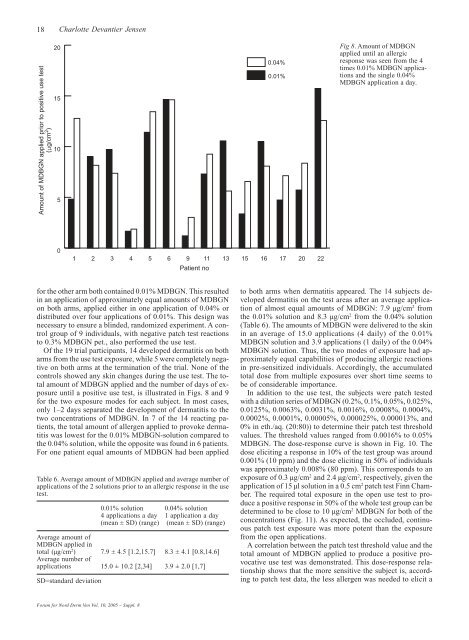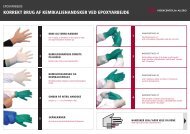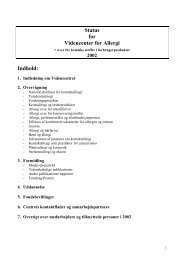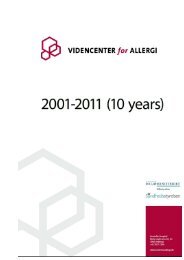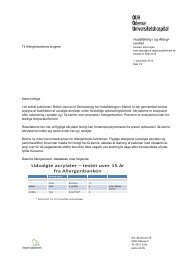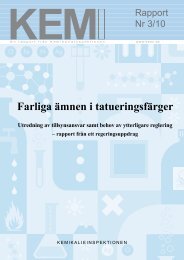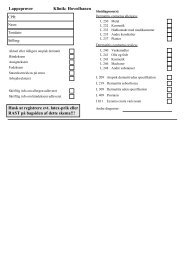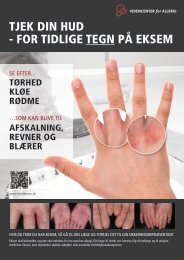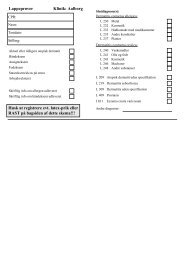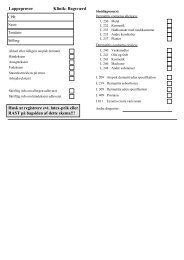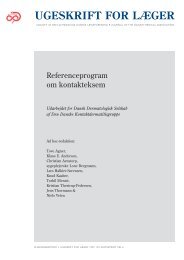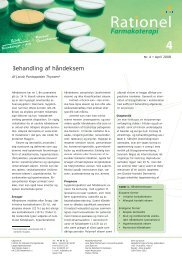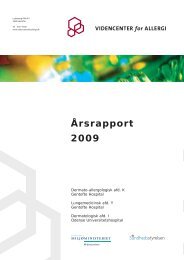Charlotte Devantier Jensen.pmd - Videncenter for Allergi
Charlotte Devantier Jensen.pmd - Videncenter for Allergi
Charlotte Devantier Jensen.pmd - Videncenter for Allergi
Create successful ePaper yourself
Turn your PDF publications into a flip-book with our unique Google optimized e-Paper software.
1188 <strong>Charlotte</strong> <strong>Devantier</strong> <strong>Jensen</strong><br />
Amount of MDBGN applied prior to positive use test<br />
(µg/cm 2 )<br />
20<br />
15<br />
10<br />
5<br />
0<br />
1<br />
<strong>for</strong> the other arm both contained 0.01% MDBGN. This resulted<br />
in an application of approximately equal amounts of MDBGN<br />
on both arms, applied either in one application of 0.04% or<br />
distributed over four applications of 0.01%. This design was<br />
necessary to ensure a blinded, randomized experiment. A control<br />
group of 9 individuals, with negative patch test reactions<br />
to 0.3% MDBGN pet., also per<strong>for</strong>med the use test.<br />
Of the 19 trial participants, 14 developed dermatitis on both<br />
arms from the use test exposure, while 5 were completely negative<br />
on both arms at the termination of the trial. None of the<br />
controls showed any skin changes during the use test. The total<br />
amount of MDBGN applied and the number of days of exposure<br />
until a positive use test, is illustrated in Figs. 8 and 9<br />
<strong>for</strong> the two exposure modes <strong>for</strong> each subject. In most cases,<br />
only 1–2 days separated the development of dermatitis to the<br />
two concentrations of MDBGN. In 7 of the 14 reacting patients,<br />
the total amount of allergen applied to provoke dermatitis<br />
was lowest <strong>for</strong> the 0.01% MDBGN-solution compared to<br />
the 0.04% solution, while the opposite was found in 6 patients.<br />
For one patient equal amounts of MDBGN had been applied<br />
Table 6. Average amount of MDBGN applied and average number of<br />
applications of the 2 solutions prior to an allergic response in the use<br />
test.<br />
0.01% solution 0.04% solution<br />
4 applications a day 1 application a day<br />
(mean ± SD) (range) (mean ± SD) (range)<br />
Average amount of<br />
MDBGN applied in<br />
total (µg/cm 2 ) 7.9 ± 4.5 [1.2,15.7] 8.3 ± 4.1 [0.8,14.6]<br />
Average number of<br />
applications 15.0 ± 10.2 [2,34] 3.9 ± 2.0 [1,7]<br />
SD=standard deviation<br />
Forum <strong>for</strong> Nord Derm Ven Vol. 10, 2005 – Suppl. 8<br />
2<br />
3<br />
4<br />
5<br />
6<br />
9<br />
11<br />
Patient no<br />
13<br />
15<br />
16<br />
0.04%<br />
0.01%<br />
17<br />
20<br />
22<br />
Fig 8. Amount of MDBGN<br />
applied until an allergic<br />
response was seen from the 4<br />
times 0.01% MDBGN applications<br />
and the single 0.04%<br />
MDBGN application a day.<br />
to both arms when dermatitis appeared. The 14 subjects developed<br />
dermatitis on the test areas after an average application<br />
of almost equal amounts of MDBGN: 7.9 µg/cm 2 from<br />
the 0.01% solution and 8.3 µg/cm 2 from the 0.04% solution<br />
(Table 6). The amounts of MDBGN were delivered to the skin<br />
in an average of 15.0 applications (4 daily) of the 0.01%<br />
MDBGN solution and 3.9 applications (1 daily) of the 0.04%<br />
MDBGN solution. Thus, the two modes of exposure had approximately<br />
equal capabilities of producing allergic reactions<br />
in pre-sensitized individuals. Accordingly, the accumulated<br />
total dose from multiple exposures over short time seems to<br />
be of considerable importance.<br />
In addition to the use test, the subjects were patch tested<br />
with a dilution series of MDBGN (0.2%, 0.1%, 0.05%, 0.025%,<br />
0.0125%, 0.0063%, 0.0031%, 0.0016%, 0.0008%, 0.0004%,<br />
0.0002%, 0.0001%, 0.00005%, 0.000025%, 0.000013%, and<br />
0% in eth./aq. (20:80)) to determine their patch test threshold<br />
values. The threshold values ranged from 0.0016% to 0.05%<br />
MDBGN. The dose-response curve is shown in Fig. 10. The<br />
dose eliciting a response in 10% of the test group was around<br />
0.001% (10 ppm) and the dose eliciting in 50% of individuals<br />
was approximately 0.008% (80 ppm). This corresponds to an<br />
exposure of 0.3 µg/cm 2 and 2.4 µg/cm 2 , respectively, given the<br />
application of 15 µl solution in a 0.5 cm 2 patch test Finn Chamber.<br />
The required total exposure in the open use test to produce<br />
a positive response in 50% of the whole test group can be<br />
determined to be close to 10 µg/cm 2 MDBGN <strong>for</strong> both of the<br />
concentrations (Fig. 11). As expected, the occluded, continuous<br />
patch test exposure was more potent than the exposure<br />
from the open applications.<br />
A correlation between the patch test threshold value and the<br />
total amount of MDBGN applied to produce a positive provocative<br />
use test was demonstrated. This dose-response relationship<br />
shows that the more sensitive the subject is, according<br />
to patch test data, the less allergen was needed to elicit a


